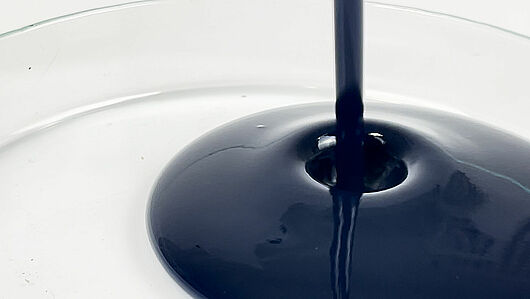Blown Fleece
Geblasene Kompositformteile aus recycelten Textilfasern und Chitosan
– Luisa Mackrodt –
Blown Fleece ist ein Konzept für eine alternative Textilproduktion und zugleich resilientere Ressourcenströme. Es stellt einen Beitrag zum nachhaltigeren Umgang mit Mode dar. Nicht zuletzt bietet es die Chance, Insekten als alternative Materiallieferanten für die Modeindustrie zu begreifen.
Hergestellt wird der gezeigte Hut aus recycelten Textilfasern in einem eigens entwickelten Apparat: Die mit Druckluft in die Form geblasenen Fasern werden von dem insektenbasierten Biokunststoff Chitosan fixiert. Exuvien, die abgelegten Häute von heranwachsenden Maden in der Insektenproduktion, dienen als regionale Rohstoffquelle für das Chitin, aus dem der lösliche Biokunststoff Chitosan hergestellt wird. In diesem Konzept findet das Chitosan zunächst Anwendung, um Farbstoffe aus Textil-Abwässern zu filtern. Die gebundenen Farbstoffe verleihen den Hüten ihre individuelle Farbgebungen.
The biopolymer chitosan can be obtained from the exoskeletons of insects in future. Dissolved in acid, it will able to filter dyes from waste water in the textile industry. It forms a hydrogel which can be processed into a composite with used recycled clothing fibers. The hat was chosen as a demonstration object to illustrate this technology. In the associated apparatus, dissolved chitosan forms the binding agent to fix fibers blown with compressed air onto a mould. The process is repeated until the composite reaches the desired thickness.
The result is a dimensionally stable yet flexible, very light fleece made from waste materials from the textile and insect processing industries.
The use of chitosan has two advantages in this concept: On the one hand, textile waste water is possibly relieved by filtering out valuable dyes. On the other hand, it can replace the usually synthetic and therefore non-biocompatible adhesives in composite materials. The use of used recycled clothing fibers also saves a lot of resources and energy. The used fibers herein come from Soex Textil-Verwertungsgesellschaft m.b.H., which has set itself the task of developing methods for the automatic separation of used clothing according to material.
The technology used is based on the so-called fiber spray process, which was originally developed for the production of composite materials, such as lightweight components for the automotive and aircraft industries. The process offers the advantage that binders can be applied to surfaces in a dosed and controlled manner. On the one hand, this makes sense as chitosan is (still) a relatively expensive residual material. On the other hand, spraying provides sufficient control and enables precise distribution of the binder on surfaces. It therefore offers the possibility of producing customized textile composites for various applications.
Possible fields of application could be in the manufacture of protective clothing, sportswear and associated equipment. Last but not least, as in this project, the creation of fashion accessories is conceivable. The aim here could be for chitosan + recycled dye + used clothing fiber to imitate materials such as denim, wool, leather and the like.
The chitosan itself, provided by BioLog Heppe GmbH, repeatedly put us to the test when working in the BioLab. In the experiments we mainly used chitosan derived from crustaceans, since the insect-based chitosan is still in development. Experimentation was made easier by the fact that the experts from the aforementioned institution were on hand to advise us. Accordingly, one of the main aspects of the project was to build on the work of scientists from different disciplines, collect existing knowledge and combine it with our own investigations.
In this way, Blown Fleece takes the promising biopolymer chitosan out of the laboratory and onto the catwalk and into the hands of consumers. As a hat, Blown Fleece manifests itself as a physically tangible object that makes it possible to experience the properties of chitosan in combination with used clothing fibers.
Blown Fleece provides ideas for alternative textile production strategies and more resilient resource flows, thus making a contribution to the sustainable use of fashion. Last but not least, it offers the opportunity to understand insects as material suppliers for the fashion industry.
entstanden im Projekt The Insect Project – Resilience Part I
entstanden im Projekt The Insect Project – Resilience Part I









